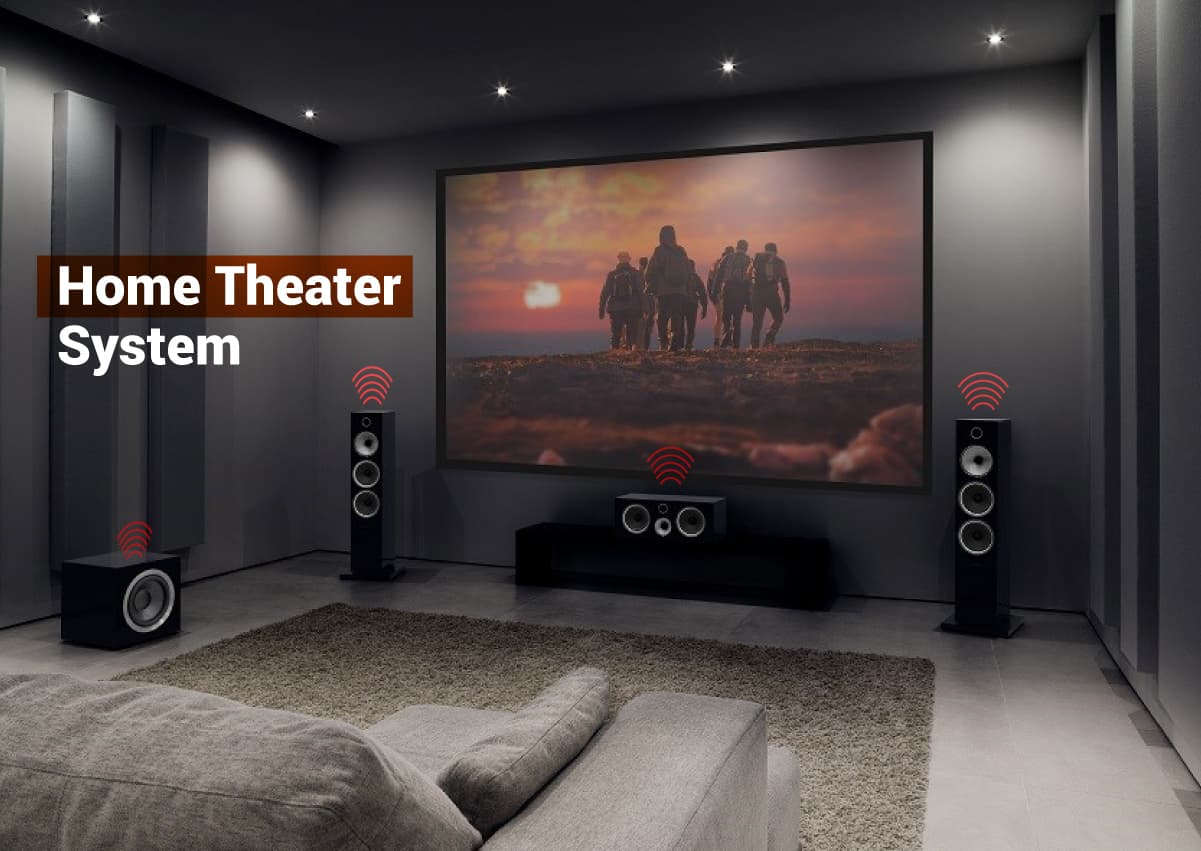M. Waleed Sheikh2024-07-25T08:47:02+00:00
Table of Contents
ToggleWhat is a Home Theater System?
A home theater system is a built-in smart setup that provides a cinematic experience for you at Home. With its HD display, high-quality speaker, and intelligent controls, you can enjoy the best screen time without going anywhere else.
What Comes with a Home Theater System?
A projector and screen are vital for home theatre if you want to avoid an LCD/LED. The main components of a home theatre system are Speakers, controllers, amplifiers, and, more importantly, the accessories that come with the design.
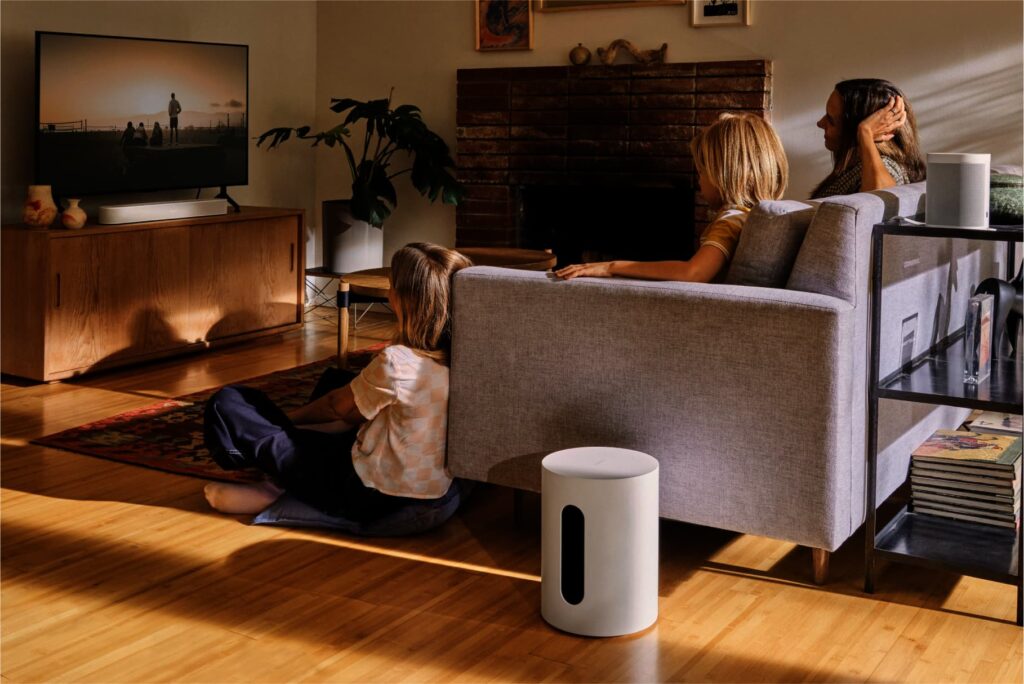
What Kind of Home Theater Systems are there?
The market is full of a diverse range of home theater systems available in the market, but a few of the most used ones include:
i) Soundbars
A soundbar is a compact and affordable option with a single bar-shaped speaker, often with a subwoofer, that can be placed below or above the TV.
ii) 2.1 Channel Systems
This system includes two speakers and a subwoofer, providing better sound quality than soundbars.
iii) 5.1 Channel Systems
This system includes five speakers and a subwoofer and can produce surround sound.
iv) 7.1 Channel Systems
This system includes seven speakers and a subwoofer, providing even more immersive surround sound.
v) Component Systems
This system includes separate components, such as a receiver, amplifier, speakers, and subwoofers, which can be customized to fit your needs and preferences.
vi) Wireless Home Theater Systems
A wireless home theater system connects the various components using wireless speakers home theater technology, providing a clutter-free setup with HD audio and video quality.
vii) Custom-Designed and Installed Home Theaters
Custom-designed and installed home theaters are home theater systems specifically designed and installed for a particular space or room in a home. These systems are usually installed by professional home theater installers working with homeowners to create a custom design that meets their needs and preferences.
Custom home theater installations can include various components, such as high-end projectors, large screens, surround sound systems, specialized seating, acoustic treatments, and smart home automation systems. These systems can be tailored to fit any space, from small rooms to large dedicated home theater rooms.
Features on Home theater Systems
Home theater systems are designed to provide a high-quality audio and video experience in the comfort of your own home. Home theater systems offer a range of features and capabilities to enhance your audio and video experience and can be customized to meet your specific needs and preferences.
Here are some features of a typical home theater installation.
Audio Quality: Home theater systems typically offer high-quality audio with clear and powerful sound. Some plans may have multiple speakers, subwoofers, and audio processing technologies like Dolby Atmos, which creates a more immersive sound experience.
Video Quality: Home theater systems often feature high-resolution video playback, with 4K or even 8K resolution support. Some systems may also have features like HDR (high dynamic range) and advanced color reproduction to enhance the visual experience.
Smart TV Integration: Many home theater systems integrate with popular smart TV platforms like Roku, Amazon Fire TV, or Apple TV, allowing you to directly access streaming services like Netflix, Hulu, and Disney+ from the home theater system.
Connectivity: Home theater systems typically offer multiple connectivity options, such as HDMI, USB, Bluetooth, and Wi-Fi, allowing you to connect various devices like gaming consoles, streaming devices, and smartphones.
Control Options: Many home theater systems come with a remote control or a smartphone app that allows you to control the system’s features and settings.
Surround Sound: Home theater systems often offer to surround sound capabilities, with speakers placed strategically around the room to create a more immersive audio experience.
Aesthetic Design: Home theater systems are designed to look stylish and blend in with your home decor. Some systems may have a minimalist design, while others may have a more traditional or modern look.
How Good is the Sound Quality of Home Theater Systems?
The sound quality contributed massively to providing an exceptional cinematic entertainment experience. The experts compare it to the live experience. That means the higher the quality of sounds while watching a series, the more you will feel to be a part of the scene. And vice versa.

The quality of sound depends on coupons many factors, including,
i) Choice of Speakers
Choose the best speakers if you want to create a magical experience. If you’re watching Netflix or enjoying some new release by K-pop, a high-quality sound can transform your experience in the best way possible. The three best home theatre wireless speakers are
- Sonos Surround Speakers Set with Arc Wireless Dolby Atmos Soundbar with Subwoofer, and Gen2 Speaker (x1).
- SVS Prime Satellite 5.1 Package.
- Bose Soundbar 900 Home Theater System with Bass Module 700 Subwoofer.
ii) Positioning of Speakers
The position is essential. Your speakers must be set up to face the audience, not the walls. It will create an echo.
iii) Room Area
For bigger rooms, install high-power speakers for a tremendous transmission.
iv) Interior
Refrain from over-cushioning your home theatre room. The soft cushioning dampens the sound and reduces the quality.
v) Power
Higher the power, the better the efficiency of the speakers.
The Advantages of Setting Up Home Audio and Home theater
i) Enhanced HD Audio Experience
A home audio or theater system provides higher-quality sound than built-in TV or computer speakers.
ii) Personalized Design
You can tailor your audio or home theater setup to your preferences, including speaker placement, sound quality, and overall design.
iii) Comfort with Luxury
With a home audio or home theater system, you can enjoy your favorite music, movies, and TV shows without leaving your home.
iv) Improved Gaming
A home audio or home theater setup enhances the audio and visual experience of gaming, making it even more immersive.
v) Worth Every Penny
Investing in a home audio or home theater system can often be more cost effective than regularly going to a movie theater or buying separate audio equipment.
vi) Add Value to your Property
A well-designed and installed home audio or home theater system can increase the overall value of your home, making it a valuable investment in the long term.
vii) Seamless Experience
With a home audio or home theater system, you can easily access and enjoy your music and movie collections and streaming services.
5 Benefits of Installing a Home Theater System
i) Improved Movie and TV Experience
A home theater system delivers enhanced sound and visual quality, allowing you to immerse yourself in your favorite movies and TV shows fully.
ii) Increased Convenience
With a home theater system, you can enjoy your favorite entertainment in the comfort of your own home without having to leave or travel to a theater.
iii) Enhanced Gaming Experience
A home theater system enhances the audio and visual experience of gaming, providing an even more immersive experience.
iv) Better Value for Money
Installing a home theater system is often more cost-effective than regularly going to a movie theater or buying high-end audio and visual equipment separately.
v) Increased Home Value
A well-designed and installed home theater system can increase the overall market value of your home, making it a valuable investment in the long term.
How do you Set Up a Home theater?
Setting up a home theater system is relatively easy. You can do it yourself if you’re familiar with cabling, equipment installation, and electrical wiring.
Let us help you out by giving a general guide to setting up a home theater system:
i) Choose a Room
Select a room with minimal outside light and sound interference.
ii) Plan Your Layout
Decide where you want to place your TV, speakers, and other components.
iii) Invest in Equipment
Choose a TV, speakers, sound system, Blu-Ray/DVD player, and any other components you may want, considering their compatibility and connectivity options.
iv) Install the TV
Mount the TV on the wall or place it on a stand. Connect it to the power outlet and other components.
v) Place the Speakers
Place the speakers in the optimal position for sound quality and aesthetics, connecting them to the sound system.
vi) Connect All Components
Connect all your components to the sound system, TV, and other necessary devices, such as a streaming device or cable box.
vii) Calibrate Your System
Calibrate your system for the best sound and picture quality by adjusting the speaker levels and picture settings on your TV.
viii) Test Your System
Test your system to ensure everything is working correctly and fine-tune any necessary settings.
Note: It’s recommended to seek the help of a professional if you need to be more comfortable setting up your home theater system yourself.
What to Consider Before Choosing a Home Theater System?
Choosing a home theater system can be an exciting but overwhelming task. There are several factors to consider before finalizing your home theater. Considering these factors, you can choose a home theater system that meets your needs and enhances your entertainment experience. Here are a few points to help you out.
Room Size: Consider the room size for setting up your home theater system. A small room may require a different setup than a large room.
Budget: Home cinema systems come in a wide range of prices. Determine your budget before you start shopping, and stick to it.
Audio Quality: Audio quality is a critical factor in a home theater system. Look for designs with high-quality speakers that provide clear, crisp sound.
Video Quality: Consider the video quality of the system. Look for a system that can play high-definition videos with clarity and detail.
Compatibility: Ensure your home cinema system is compatible with your TV, streaming devices, and gaming consoles. You must ensure that the system is easy to set up and use. Look for systems with intuitive user interfaces and straightforward controls.
Room Design: The design of your room can impact the audio quality of your home theater system. Choose a system that works well with your room’s layout and acoustics.
Brand Reputation: Look for a reputable brand with a proven track record of providing high-quality home theater systems.
How to Choose a Home Theater System?
It’s a simple question that needs just one answer. Choose Per Need.
Look at your home interior and decide which home theatre suits your place. Or ask aHome Theater System Buying Guide
Every home has different needs. You cannot just go for a home theatre system because a friend bought it and it’s working perfectly at his place. Or you saw an ad, and they told you it’s the best home theatre system. Now you will ask, which home theatre is best for my Home? The answer is the one that will fit your home needs.
We can give you a brief guideline that will help you to decide which home theatre system you should buy according to your home needs.
i) Set a Budget
Your budget is your domain. Estimate an amount after researching your home theatre system installation in Canada. The actual cost can be +-10% of the estimated cost.
ii) Setting
The place you want to dedicate to your cinematic setup is the prime location to review. You must purchase high-power speakers if the Home has big wide windows. You can go quickly for an average power speaker for a small room on the ground floor.
iii) Select the Style that’s Right for you
As we discussed, the home theatre also adds aesthetics to your place; select the style of speakers and screen alignment for installation that makes your residence more eye-capturing. Refrain from overdoing it, so it looks like a mess.
iv) Choose your Level of Customization
You can customize your home theatre setup by integrating it with smart lights, a home audio system, and motorized blinds. Add options to your notes.
v) Choose the Number of Speakers – 5/5.1, 6/6.1, 7/7.1
a) 5 or 5.1
This topology of a five-speaker system has a subwoofer with speakers. They are arranged so that two speakers are on the front, two back speakers, and a front center speaker.
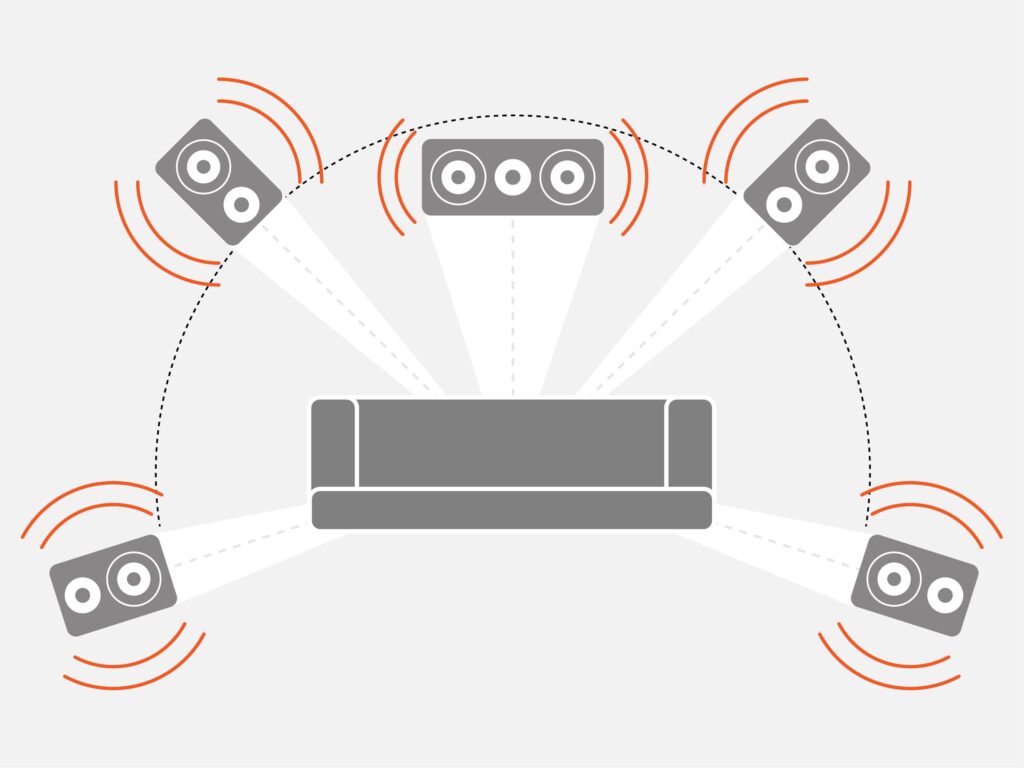
b) 6 or 6.1
A 6/6.1 typology has two front speakers, two back speakers, a front center speaker, plus a rear center speaker. A 6.1 system differs from 6 i-e 6.1 has an additional subwoofer.

c) 7 or 7.1
A 7/7.1 typology has two front speakers, two back speakers, a front center speaker, plus two side speakers. A 7.1 system has all of the above plus a subwoofer. Remember, a “.1″ at the end of 7 represents that one subwoofer is included in this setup.
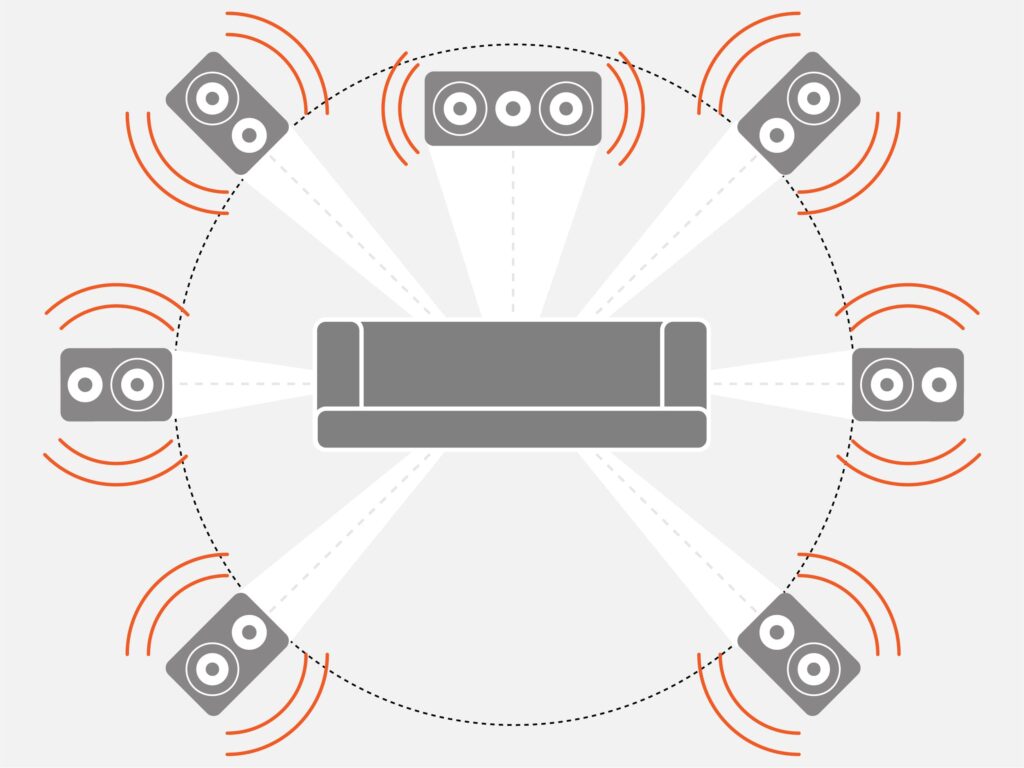
How Much Power does a Home Theater System Need?
It depends on the efficiency of the speakers and your desired listening level. The size of the room is another factor. The larger area needs more powerful speakers to transmit sound effectively, while the smaller site works on average speakers. A complete home theatre system needs around 660-1100 Watts of power to operate, whereas a 5.1-channel home theatre with a powered subwoofer consumes 244 watts.
What is Surround Sound, and Why do I Want it at Home?
Surround sound is a method of audio reproduction that creates an immersive experience by placing speakers around the listener. The goal of surround sound is to mimic the experience of being in a live performance or in the middle of the action in a movie.
There are several surround sound configurations, including 5.1, 7.1, and 9.1, which refer to the number of speakers used. The most common type is 5.1, which uses five speakers and a subwoofer.
Why do I Need Surround Sound at Home?
We gathered a few reasons to convince why you may want surround sound in your home:
- Surround sound provides a more immersive and realistic audio experience and makes your screen time worth it. You might prefer to avoid seeing movies and podcasts with compromised audio quality, and surround speakers ensure you do not.
- Surround sound, with its 360-degree sound dispersion, creates an illusion of sound coming from different directions, making you feel like you’re part of the action.
- Surround sound allows you to control the volume of every speaker individually, and you can customize your audio as per your need.
- Adding surround sound to your home theater system can significantly enhance your movie, TV, and gaming experience by providing a more immersive and realistic audio experience.
What Surround Sound Speaker Layout Do You Want?
Let us show you a few layout designs so you can choose from one of them.
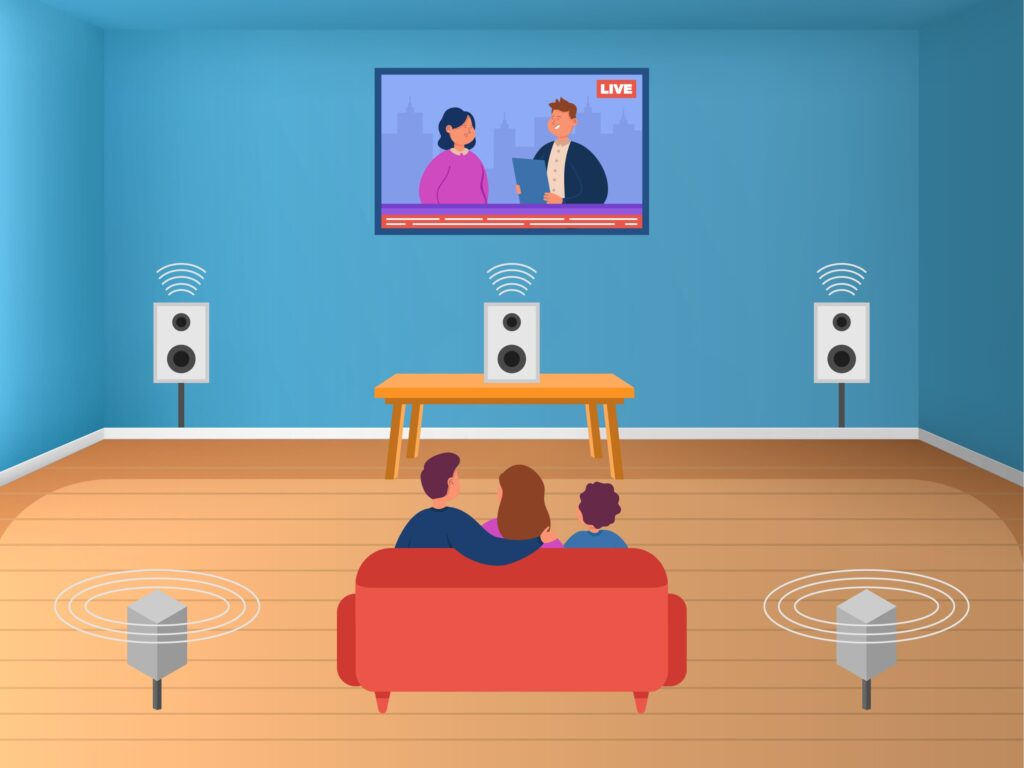

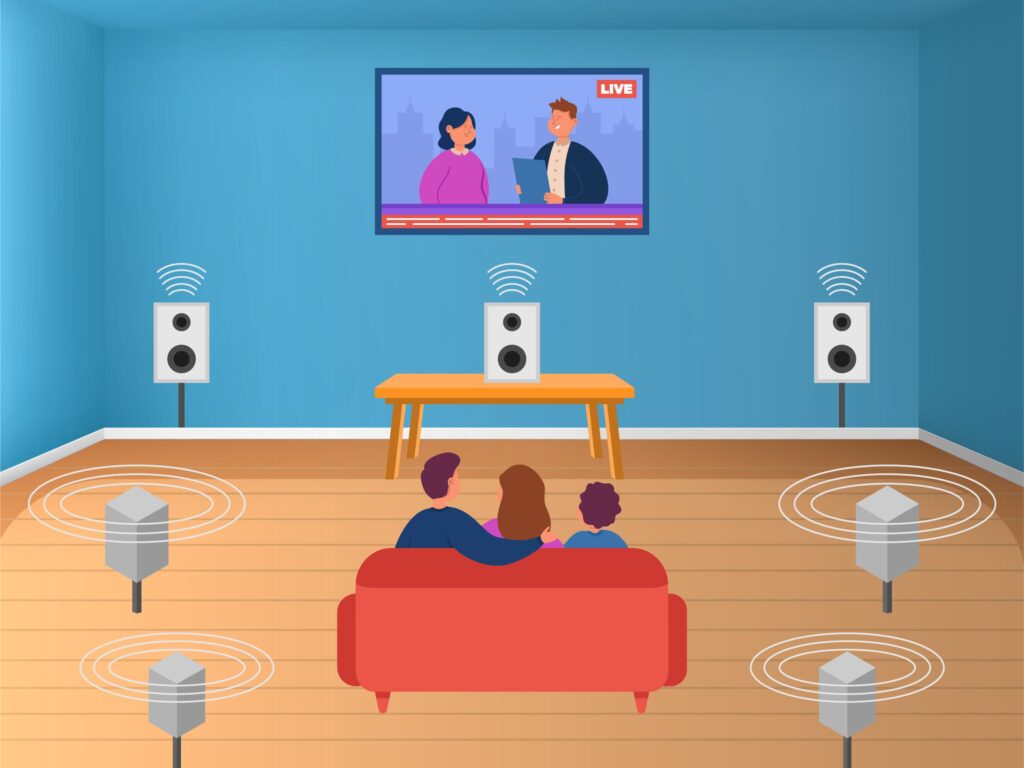
FAQs
The traditional home theatre includes Projector or HD TV screen, an Audio system with 5 or 7 speakers: a center speaker, left and right speaker, rear left and right speakers, a subwoofer, and an AV receiver.
If you want your home theatre to be perfect, we have a few recommendations for you to experience the best cinematic enchantment.
- Room Acoustics: Pay attention to the acoustics of your room. Consider sound-absorbing materials, acoustic panels, or curtains to minimize echo and enhance audio quality.
- Lighting and Ambiance: Install appropriate lighting solutions to create a theatre-like atmosphere. Smart lighting systems are an excellent choice for your home theatre. It can control the room’s brightness during different viewing scenarios.
- Cable Management: Plan proper cable management to keep wires organized and hidden from view. This ensures a clean and clutter-free appearance.
- Universal Remote or Smart Home Integration: Simplify control over your home theatre system using a universal remote or integrating it into a smart home automation system for convenient operation.
How do you Hook Up a Home Theater System?
Hooking up a home theater installation can be a bit complex, but following these steps should help simplify the process:
- Determine the placement of your home theater components, such as the TV, receiver, and speakers.
- Connect the TV to the receiver through an HDMI cable.
- Connect your video sources, such as a cable box or Blu-ray player, to the receiver using HDMI cables.
- Connect the speakers to the receiver. Make sure the positive and negative terminals match.
- Follow the setup prompts to turn on your TV, receiver, and other components.
- Configure the settings on your receiver to match your room’s acoustics and speaker setup.
- Test the system by playing some audio and video content.
The time it takes to hook up a home cinema system depends on the complexity of the setup and the level of experience of the person doing it. If you have some knowledge of audio and video systems, you can complete the design in a few hours. However, completing the setup may take several hours or more if you are new to home theater systems. In any case, it’s best to take your time and ensure that everything is correctly connected and configured to get the best performance out of your system.
The choice of home theater receiver depends on your current setup. We’d recommend looking at NetraClos Home Theater System to see a diverse range of options in your budget and fit your needs!
If you still need clarification, Don’t Worry! You can always reach out to us at our official contact number, +1 647 725 9693, where we help you to choose by figuring out precisely what you need! We are your digital Home Theater Buying Guide
The amplifier is required to increase the output level to a desirable level. An amplifier is unnecessary if you think you do not need higher output.
If you are looking everywhere to get a lead but are still trying to decide, you need an expert to advise. We have experts to tell you this. The tech analysts can facilitate your queries on a call as well. Let’s talk and discuss.
The speakers can be wireless, but the LCD/LED has wires. If you want to connect a home theatre to a PC, you need an HDMI cable.
The Wattage required for a sound home theater system depends on several factors, including the size of the room, the speakers’ sensitivity, and the listener’s personal preferences. As a general rule of thumb, a 5.1 home theater system should have a total power output of at least 500 watts for a medium-sized room (up to 300 square feet), while a more prominent space may require up to 1000 watts.
The Wattage you should get for your home theater system will depend on several factors, including the area of your room, the type of home theater speakers you have, and your preferences for volume and sound quality.
Ensure you have the minimum Wattage recommended for your specific speakers, at the very least. Humans can clearly distinguish and feel the volume changes of three decibels, which needs doubling the power. Let us explain it to you; suppose you currently have 70 watts per channel but want a significant increase in audio level. To do it, you’d need double the power, i.e.,140, watts per channel.
So, 125 watts per channel is the ideal watts of power suitable for you without fear of running out.
The terms “home theatre” and “home cinema” are interchangeable but there is a slight difference in basic concepts.
Home theatre typically refers to a home entertainment setup focused on recreating a movie theatre experience. A home theatre includes a large screen or projector, surround sound speakers, and comfortable seating arranged in a way that mimics a theatre.
On the other hand, home cinema is a more immersive and high-end entertainment experience designed to replicate the experience of being in a dedicated movie theatre. A home cinema typically includes a larger screen or projector, high-quality sound systems, and customized lighting to create a cinematic experience.
Choosing the right speakers for home theater can be daunting, but ensuring you get the best sound quality possible is essential.
Think about where you want to place your speakers. The front speakers must be installed to meet the ear level, while the center speaker should be above or below the TV. Rear speakers should be placed behind the listener, while the subwoofer has no issue. You can place them anywhere in the room.
Look for home theater speakers with a balanced sound, with clear highs, mids, and lows. Consider a speaker’s frequency response range, which indicates the range of frequencies the speaker can produce.
Finally, consider the brand and price of the speakers for home theater. Well-known brands may offer better quality but may also come with a higher price tag. Set a budget and look for speakers that fit within your price range.
There are a few options available for you for home theater speakers. Depending upon the size of your area, you can either go for 5.1 Or 7.1 Surround Sound speakers.
All speakers in a home theater system are essential and work together to create an immersive and balanced audio experience. However, if we have to identify the most important speaker in a home theater system, it would be the center channel speaker.
The center channel speaker reproduces most of the dialogue and on-screen action, making it critical to the listening experience. It is also responsible for anchoring the sound to the screen and creating a seamless soundstage between the left and right front speakers.
Let’s say you want wireless surround speakers. Converting your conventional speakers into wireless speaker’s home theater is a terrific way to declutter your home with a more advanced theater setup. One way is to add a wireless adapter with a wired speaker. In that instance, when extending wires to the room’s rear is difficult or impossible, some manufacturers offer systems with optional wireless capabilities for the surround speakers. As a leading manufacturer of wireless speaker’s home theater, Bose springs to mind. Two more big names in the race of wireless speaker’s home theaters are Sonos and Russound,
It depends on your needs. 5.1 has two fronts, two back, and one front central speaker. Whereas 7.1 is similar to 5.1 but with two central side speakers, giving a more precise 360 degrees of sound propagation. 7.1 is an excellent choice if you have a vast area of the cinema room.
Image result for which is better, a soundbar or a home theater?
Nowadays, consumers generally have the option of either a soundbar or a home theater system. Soundbars combine good sound quality and volume in a compact form factor – but when it comes to an immersive audio experience, a home theater system is the preferred option for some users.
As a general rule of thumb, a 5.1 home theater system is well-suited for a room up to 300 square feet, with a seating distance of about 6-8 feet from the screen.
Yes, you can connect your laptop or pc to your home theater system using an HDMI cable.
With its diverse high-quality 5.1 and 7.1 surround speakers, you can enjoy uninterrupted music on your home theatre system.
Choosing the perfect home theatre surround system can be a real challenge, as there are multiple factors to consider. The best option for home theater depends on your personal preferences, budget, room size, and audio quality expectations. There are, however, some famous and highly regarded home theatre surround systems that experts and users recommend. Here are a few of them:
- The Sonos Arc is an impressive soundbar that provides an immersive audio experience with Dolby Atmos support. It offers excellent sound quality, clear dialogue, and a wide soundstage. You can pair the soundbar with additional Sonos speakers for a complete surround sound setup.
- The Bose Lifestyle 650 is a premium home theatre system with a sound bar, wireless subwoofer, and satellite speakers. It supports 5.1 surround sound and delivers exceptional sound quality and clarity.
- Paradigm is a brand known for its high-quality speakers and home theatre systems. They offer a wide range of speakers, including floor-standing speakers, bookshelf speakers, center channel speakers, and subwoofers that combine to create a complete surround sound setup.
Determining the “best” home theater system is subjective and depends on several factors, such as budget, room size, desired features, and personal preferences. Some popular home theater systems include:
- Sonos Beam: The Sonos Beam is a compact soundbar that delivers powerful sound and supports voice control with Amazon Alexa and Google Assistant.
- Sony SRS-X9: This wireless speaker system has powerful sound and a range of features, including multi-room capability and compatibility with various devices.
- Bose SoundTouch 300: This sleek and compact soundbar has excellent sound quality and various features, including Alexa voice control and compatibility with multiple devices.
- Yamaha YAS-209: This soundbar system has good sound quality, Alexa voice control, and support for 4K video.
- Vizio M Series: This affordable soundbar system has good sound quality, support for Dolby Atmos, and a range of features, including compatibility with various devices.
- Samsung HW-Q90R: This high-end soundbar system has a powerful sound, support for Dolby Atmos, and a range of features, including compatibility with Samsung SmartThings.
Ultimately, the best home theater system for you will depend on your specific needs and preferences. It’s essential to research, compare products, read reviews, and consult with an expert before making a decision.
The best home theater system for a house will depend on several factors, such as room size, personal preferences, budget, and desired features. Some popular home theater brands include:
Your house’s best home theater system will ultimately depend on your specific needs and budget. It’s essential to research and compare different options, read reviews, and consult with an expert before making a decision.
| Brand | Salient Features | |
| 1 | Sony | Excellent sound quality, 4K UHD Resolution, Bluetooth Connectivity, including soundbars, and subwoofers, Compatible with Blu-ray players, and gaming consoles. |
| 2 | Sonos | Wireless Streaming, Multi-Room Audio, and Voice Control receive regular software updates. |
| 3 | Bose | High-quality audio, delivering powerful bass and clear treble, compatible with Amazon Alexa and Google Assistant, Sleek Design, and Budgeted noise-cancellation technology. |
| 4 | Samsung | Good sound quality and various features, support for 4K video, and compatibility with Samsung SmartThings. |
As we discussed above, your home theatre must fulfill the requirements of your place. If you still need to learn, call +1 647-725-9693 to discuss it with a tech specialist.
The warranty for a home theater system can vary depending on the manufacturer and the specific model. It is essential to carefully review the warranty information before purchasing a home cinema system to get a clear understanding of what you are signing up for and for how long. A Home Theater Buying Guide can help you out in this regard.
Home theatre is worth it. It is a fantastic choice if you plan to install one. Home theatre system takes your experience of watching TV to the next level.
The cost relies on your choice of home theatre and surround speakers. However, a general estimate lies between $700-CAD $3500.

